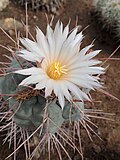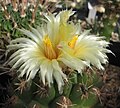Thelocactus
This article needs additional citations for verification. (January 2012) |
| Thelocactus | |
|---|---|

| |
| Thelocactus rinconensis | |
| Scientific classification | |
| Kingdom: | Plantae |
| Clade: | Tracheophytes |
| Clade: | Angiosperms |
| Clade: | Eudicots |
| Order: | Caryophyllales |
| Family: | Cactaceae |
| Subfamily: | Cactoideae |
| Tribe: | Cacteae |
| Genus: | Thelocactus (K.Schum.) Britton & Rose[1] |
| Type species | |
| Thelocactus hexaedrophorus | |
| Species | |
|
See text | |
| Synonyms | |


Thelocactus is a genus of flowering plants in the cactus family Cactaceae. Members of the genus are native to the arid lands of Central and Northern Mexico.
Description[edit]
Thelocactus species are globe-shaped, short and cylindrical. They are small cacti, although there are one or two species which, while only about 15 cm high, can be 25 cm in diameter; for example, T. nidulans. Thelocactus species are generally solitary, but some varieties will cluster in groups.
The ribs on Thelocactus species are very clearly marked and are sometimes twisted in a spiral. There can be from 8 to 20 ribs, which are rather low and normally marked with raised, angular or hexagonal tubercles. These tubercles can sometimes be difficult to distinguish. Areoles sit in a furrow directly above where the spines grow and there can be up to twenty radial/radiating spines. They are often needle-like, spread out and can be from 1.3 – 1.5 cm long. The central spines are mostly coarser, number up to six, stand vertically out from the plant and can be 2.5 – 7.5 cm long. Colours of all of the spines vary and include white, gray, golden-yellow and red-brown.
Flowers grow from the new areoles at the very top of the plant. They are funnel-shaped, have a diameter of 2.5 – 7.5 cm and their colours vary from white to shades of yellow, red or purple. They are diurnal. Fruits are small, globe-shaped and plain. They are dehiscent through the large basal pore, green to brownish purple [to magenta], spherical to short cylindrical, 5 - 18 x 6 – 17 mm, not juicy, drying immediately after ripening, scaly, spineless, hairless and with floral remnant persistent.
Distribution[edit]
Thelocactus species grow in the wild in central and North Mexico and in the US in Texas. In Mexico, the species are generally concentrated along and to the west of the Sierra Madre Oriental beginning with T. hastifer in Querétaro State, about 150 km NNW of Mexico City. One subspecies (T. bicolor ssp. flavidispinus) grows on the other (northern) side of the Rio Grande, well distributed in the Big Bend area of Texas. Other occurrences of T. bicolor in Texas have been reported but cited verification is sketchy although it would be odd if they did not occur there. Some species are distributed over a wide area of many Mexican states (T. bicolor and its subspecies and T. hexaedrophorus) with T. bicolor and its current (2013) botanically accepted subspecies bolaensis, flavidispinus, heterochromus and schwarzii having the widest distribution. In contrast, one species, T. lausseri, only occurs in one known remote locality in central Coahuila state. Species are distributed in mountainous stony/rocky places or grassy territory with clay soil.
Cultivation[edit]
Thelocactus species are generally easy to cultivate, even if many species fail to flower until they are five years old. Soils should be composed of equal proportions of sand and humus. Water normally from Spring to Autumn. In Winter, keep most species at a minimum temperature of 8 °C. They can survive at lower temperatures but the roots then must be kept dry. The dark brown or black seeds can be relatively large for the size of cactus and they germinate readily.
Reproduction is nearly always from seed, since the plant rarely produces plantlets. The seed should be put in a sand and compost mixture, kept moist, maintained at a temperature of 21 °C and placed in a shady position.
Thelocactus bicolor has gained the Royal Horticultural Society's Award of Garden Merit.[2]
Synonymy[edit]
The following genera have been brought to synonymy with Thelocactus:
This genus contained 8 species and was known from the Southwest United States and in northern Mexico. The name Hamatocactus means "hooked cactus" in Latin.
- Thelomastus Fric (nom. inval.)
Species[edit]
Species recognized by International Cactaceae Systematics Group. (Anderson E. F., 2001)
| Image | Scientific name | Sub-species | Distribution |
|---|---|---|---|
 |
Thelocactus bicolor (Galeotti ex Pfeiffer) Britton & Rose |
|
northern Chihuahuan Desert of the USA (Texas) and Mexico. |
 |
Thelocactus conothelos (Regel & Klein) Backeb. & F.M.Knuth |
|
Mexico (Chihuahua, Coahuila de Zaragoza, Durango, Nuevo León, Tamaulipas) |
| Thelocactus garciae Glass & M.Mendoza | Mexico (Tamaulipas ) | ||
 |
Thelocactus hastifer (Werdermann & Boedeker) F.M.Knuth | Mexico (Querétaro de Arteaga) | |
| Thelocactus heterochrontus (F.A.C.Weber) Oosten | Mexico(Chihuahua, Durango, Zacatecas ) | ||
 |
Thelocactus hexaedrophorus (Lemaire) Britton & Rose |
|
Mexico (Nuevo León, San Luis Potosí, Tamaulipas, Zacatecas) |
 |
Thelocactus lausseri Riha & Busek | Mexico ( Coahuila de Zaragoza ) | |
 |
Thelocactus leucacanthus (Zuccarini) Britton & Rose |
|
Mexico (Hidalgo, Querétaro de Arteaga) |
 |
Thelocactus macdowellii (Rebut ex Quehl) Glass | Mexico (Coahuila de Zaragoza, Nuevo León) | |
 |
Thelocactus rinconensis (Poselger) Britton & Rose |
|
Mexico (Coahuila de Zaragoza, Nuevo León) |
 |
Thelocactus setispinus (Engelmann) E.F.Anderson |
(syn. Hamatocactus setispinus) |
Mexico (Coahuila de Zaragoza, Nuevo León, Tamaulipas), USA (Texas) |
 |
Thelocactus tulensis (Poselger) Britton & Rose |
|
Mexico(Nuevo León, San Luis Potosí, Tamaulipas ) |
Formerly placed here[edit]
- Turbinicarpus beguinii (N.P.Taylor) Mosco & Zanov. (as T. beguinii N.P.Taylor)
- Turbinicarpus gielsdorfianus (Werderm.) V.John & Ríha (as T. gielsdorfianus (Werderm.) Borg)
- Turbinicarpus horripilus (Lem.) V.John & Ríha (as T. horripilus (Lem.) Kladiwa)
- Turbinicarpus knuthianus (Boed.) V.John & Ríha (as T. knuthianus (Boed.) Borg)
- Turbinicarpus lophophoroides (Werderm.) Buxb. & Backeb. (as T. lophophoroides Werderm.)
- Turbinicarpus mandragora (Fric ex A.Berger) A.D.Zimm. (as T. mandragora A.Berger)
- Turbinicarpus pseudopectinatus (Backeb.) Glass & R.A.Foster (as T. pseudopectinatus (Backeb.) E.F.Anderson & Boke)
- Turbinicarpus saueri (Boed.) V.John & Ríha (as T. saueri (Boed.) Borg)
- Turbinicarpus subterraneus (Backeb.) A.D.Zimm. (as T. subterraneus (Backeb.) Backeb. & F.M.Knuth)
- Turbinicarpus viereckii (Werderm.) V.John & Ríha (as T. viereckii (Werderm.) Bravo)
- Turbinicarpus ysabelae (Schlange) V.John & Ríha (as T. ysabelae Schlange)[3]
References[edit]
- ^ a b "Genus: Thelocactus (K. Schum.) Britton & Rose". Germplasm Resources Information Network. United States Department of Agriculture. 2004-02-13. Retrieved 2010-11-10.
- ^ "RHS Plant Selector - Theolcactus bicolor". Retrieved 6 June 2013.
- ^ "GRIN Species Records of Thelocactus". Germplasm Resources Information Network. United States Department of Agriculture. Retrieved 2010-11-10.
- This article has been expanded using, inter alia, material based on a translation of an article from the Swedish Wikipedia, by the same name. It has also been augmented by material translated from the Italian Wikipedia.
Literature[edit]
- Edward F. Anderson: A revision of the genus Thelocactus B. & R. (Cactaceae). In: Bradleya. Band 5, 1987, S. 49–76.
- Grzegorz F. Matuszewski, Stanisław Hinz: Thelocactus. Systematik, Vorkommen und Kultur. 2011, ISBN 978-83-932646-0-5.
- Alessandro Mosco, Carlo Zanovello: A phenetic analysis of the genus Thelocactus. In: Bradleya, Band 18, 2000, S. 45–70, PDF.
- Alessandro Mosco, Carlo Zanovello: An introduction to the genus Thelocactus. In: Cactus & Co. Band 6, Nummer 3, 2002, S. 144–171, PDF.
External links[edit]
![]() Media related to Thelocactus at Wikimedia Commons
Media related to Thelocactus at Wikimedia Commons
